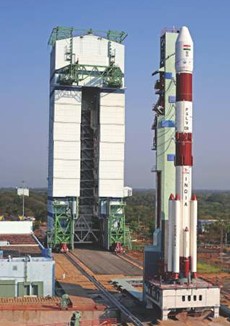Isro launches space observatory Astrosat
28 Sep 2015
The Indian Space Research Organisation (Isro) today, Monday, successfully launched India's first space observatory, Astrosat, which will be used to study distant celestial objects.
 Astrosat, part of a payload of 1,631kg, was launched from the First Launch Pad of Satish Dhawan Space Centre SHAR, Sriharikota, using Isro's workhorse PSLV.
Astrosat, part of a payload of 1,631kg, was launched from the First Launch Pad of Satish Dhawan Space Centre SHAR, Sriharikota, using Isro's workhorse PSLV.
The tenth flight of PSLV in its "XL" configuration, the PSLV-C30 rocket successfully placed Astosat in its orbit within 22 minutes after lift-off from the Satish Dhawan Space Centre at 10am.
Within a few minutes, Canada's NLS-14 nanosatellite, Indonesia's LAPAN-A2 microsatellite and four identical LEMUR nano satellites for the United States were also placed in orbit.
The first dedicated multi wavelength space observatory, Astrosat aims at understanding the high energy processes in binary star systems containing neutron stars and black holes, to estimate the magnetic fields of neutron stars and to study star birth regions and high energy processes in star systems lying beyond the Milky Way galaxy.
The 1,513kg cuboid-shaped satellite would be eventually fine-tuned 650 km above the Earth's surface.
The satellite can simultaneously perform multi-wavelength observations of various astronomical objects. The sun and star sensors, besides the gyroscopes, would provide orientation reference to the satellite, which has a mission life of five years.
The mission also expects to detect new briefly bright X-ray sources in the sky, to perform a limited deep field survey of the Universe in the ultraviolet region.
A team headed by Prof UR Rao finalised the five payloads, which were taken onboard the Astrosat – Ultraviolet Imaging Telescope, Large Area X-Ray Proportional Counter, Soft X-ray Telescope and Cadmium Zinc Telluride Imager.
The instruments, spreading across ultraviolet and X-ray wavelengths, will study black holes, neutron stars, quasars, white dwarfs and pulsars.
"Astrosat is special due to the choice of instruments to study in multi-wave lengths - UV rays, visible and X-rays - which even the Hubble doesn't have," A S Kiran Kumar, chairman of the Indian Space Research Organisation (Isro), said in a recent interview. "The instruments allow simultaneous observation of cosmic sources, an area in which other observatories currently have limitations."
Isro's planetary exploratory group and the Indian Institute of Science have also contributed to the spacecraft, which carries four X-ray payloads, a UV telescope and a charge particle monitor.
Though Astrosat may be similar to the NASA's Hubble Space Telescope, it is about 10 times smaller and cannot be compared to the Hubble, which is versatile.
Besides NASA, space agencies of the European Union, Japan and Russia have launched similar facilities into the space.
The Rs178 crore Astrosat is India's first space observatory. India's observatory will be the fourth in space, after the Hubble, Russia's Spektr R and Suzaku of Japan.
Astrosat, initially planned for 2005, has been delayed by a decade, as the scientific community struggled to build with precision the instruments needed for such operations, according to reports.
Six small satellites, including four from the US and one each from Indonesia and Canada, will be on board which will place these satellites in the Earth's lower orbit.
While Canada's NLS-14 is a maritime monitoring nanosatellite using the Automatic Identification System, Indonesia's LAPAN-A2 is aimed at benefitting Indonesian radio amateur communities for disaster mitigation and carrying out Earth surveillance. All the four identical LEMUR satellites for the United States - non-visual remote sensing satellites aims to focus on global maritime intelligence through vessel tracking.













.jpg)






.jpg)









